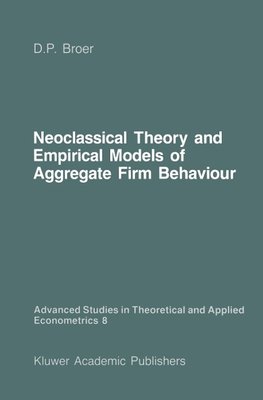
-
 Anglický jazyk
Anglický jazyk
Neoclassical Theory and Empirical Models of Aggregate Firm Behaviour
Autor: D. Peter Broer
I. Introduction.- 1.1 Scope and significance.- 1.2 Methodological considerations.- 1.2.1 The use of theoretical restrictions in empirical macro-models.- 1.2.2 Research programmes in economics.- 1.2.3 Decisionmaking and rationality.- 1.2.4 Rationality and... Viac o knihe
Na objednávku, dodanie 2-4 týždne
49.49 €
bežná cena: 54.99 €
O knihe
I. Introduction.- 1.1 Scope and significance.- 1.2 Methodological considerations.- 1.2.1 The use of theoretical restrictions in empirical macro-models.- 1.2.2 Research programmes in economics.- 1.2.3 Decisionmaking and rationality.- 1.2.4 Rationality and information.- 1.3 An outline of the remaining chapters.- II. Some elements from the neoclassical research programme of the firm.- 2.1 Introduction.- 2.2 Keynesian theories of the firm.- 2.3 The neoclassical programme.- 2.3.1 Factor demand studies.- 2.3.2 Vintage technology models.- 2.3.3 Investment theory and economic scrap.- 2.3.4 Dynamics of the neoclassical model.- 2.3.5 Utilization of quasi-fixed factors.- 2.3.6 Market theories of investment.- 2.3.7 Output markets and prices.- 2.4 An outline of the structure of the models of this study.- 2.4.1 A model with a homogeneous capital stock.- 2.4.2 A putty-clay model.- III. A neoclassical model of a firm subject to a putty-putty technology.- 3.1 The market- and information structure.- 3.2 The production structure.- 3.3 The full model.- 3.4 Existence of an optimal policy.- 3.5 Necessary conditions for an optimal policy.- 3.5.1 The steady-state solution.- 3.5.2 The dynamic adjustment path.- 3.5.2.1 The short-term problem.- 3.5.2.2 The medium-term problem.- 3.6 Approximate solutions.- 3.7 Comparison with the stock adjustment specification.- Appendix 3a.- Appendix 3b.- Appendix 3c.- Appendix 3d.- Appendix 3e.- IV. Vintage technologies and the theory of the firm.- 4.1 Introduction.- 4.2 The structure of putty-clay models.- 4.2.1 Existence.- 4.2.2 Properties of an optimal policy.- 4.2.3 The steady-state.- 4.2.4 Approximate solution procedures.- 4.3 A general putty-clay model.- 4.3.1 Necessary conditions for an optimal policy.- 4.3.2 The steady-state solution.- 4.3.3 Discussion of the model.- 4.3.4 A solution method by shadow price approximation.- Appendix 4a.- V Estimation and empirical testing of the putty-putty model.- 5.1 Discrete-time adaptions.- 5.2 The construction of the expectations.- 5.3 Estimation.- 5.4 Model specification tests.- 5.5 Model characteristics.- 5.5.1 Stochastic stability.- 5.5.2 Feedback effects.- 5.5.3 Multiplier analysis.- 5.6 Trends and fluctuations.- Appendix 5a.- Appendix 5b Data sources and definitions.- Appendix 5c Summary of the putty-putty model.- VI. Estimation and testing of the putty-clay model.- 6.1 Discrete-time adaptions.- 6.2 Estimation.- 6.3 Model specification tests.- 6.4 Model characteristics.- 6.4.1 Stochastic stability.- 6.4.2 Feedback effects.- 6.4.3 Multiplier analysis.- 6.5 Trends and fluctuations.- Appendix 6a Summary of the putty-clay model.- VII. Summary and conclusion.- 7.1 Summary.- 7.2 Conclusion.- List of symbols.- References.- Author index.
- Vydavateľstvo: Springer Netherlands
- Rok vydania: 2011
- Formát: Paperback
- Rozmer: 235 x 155 mm
- Jazyk: Anglický jazyk
- ISBN: 9789401084949












